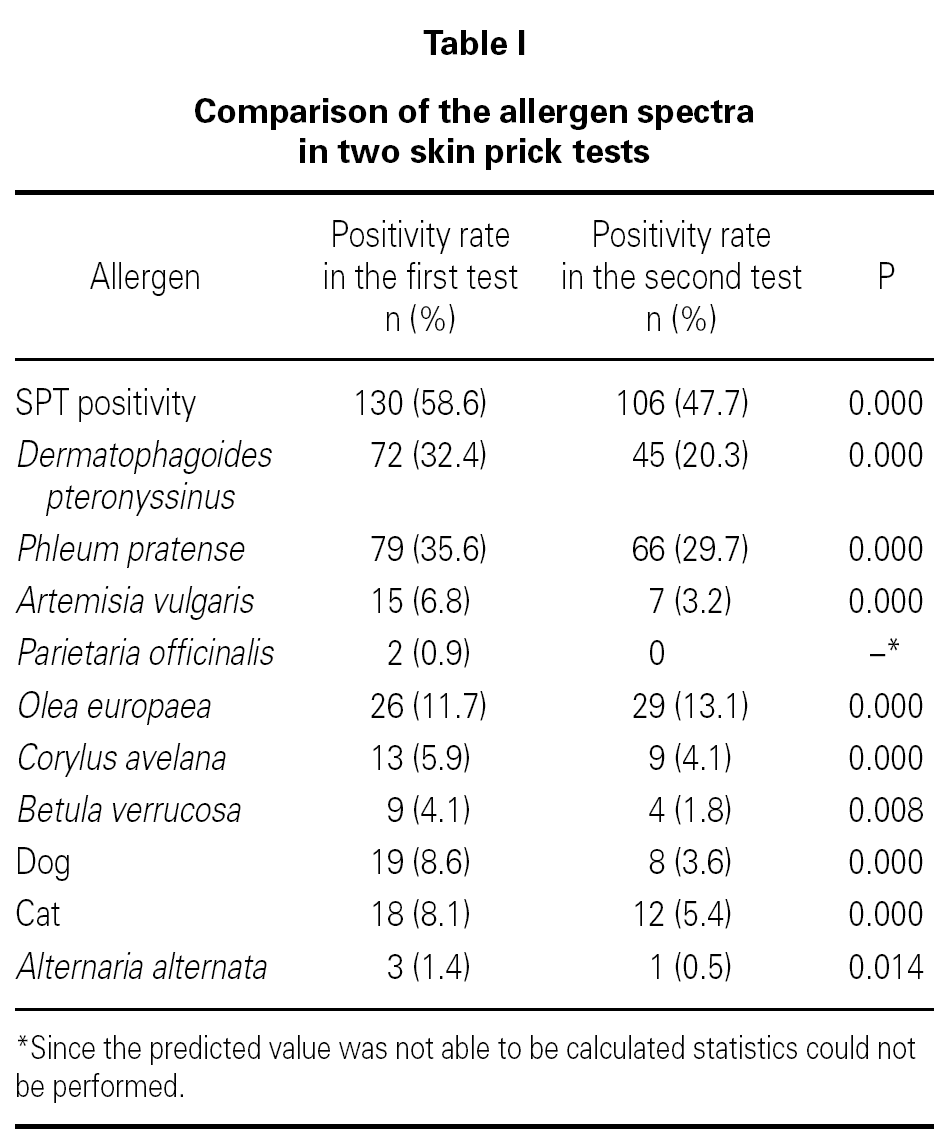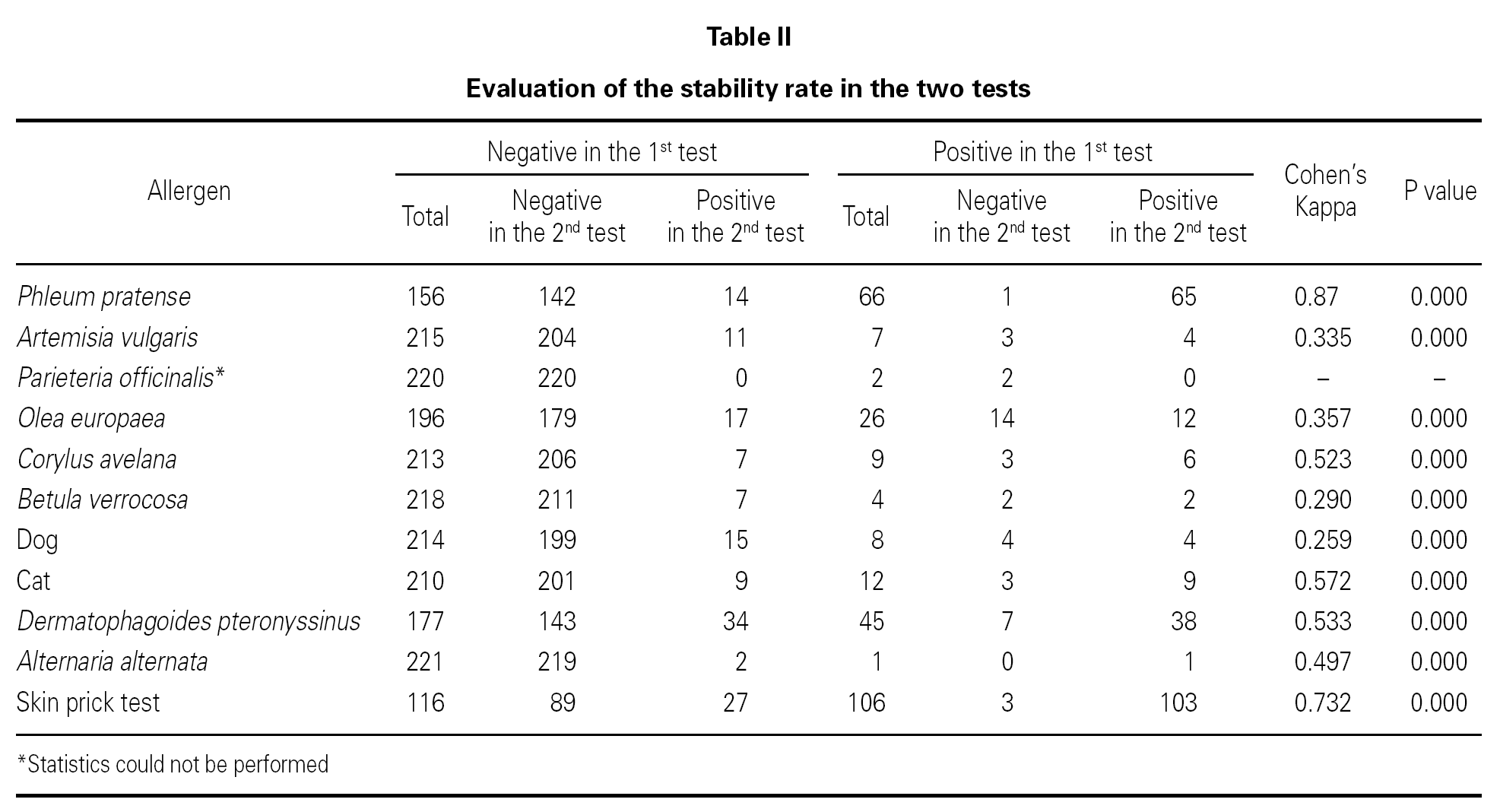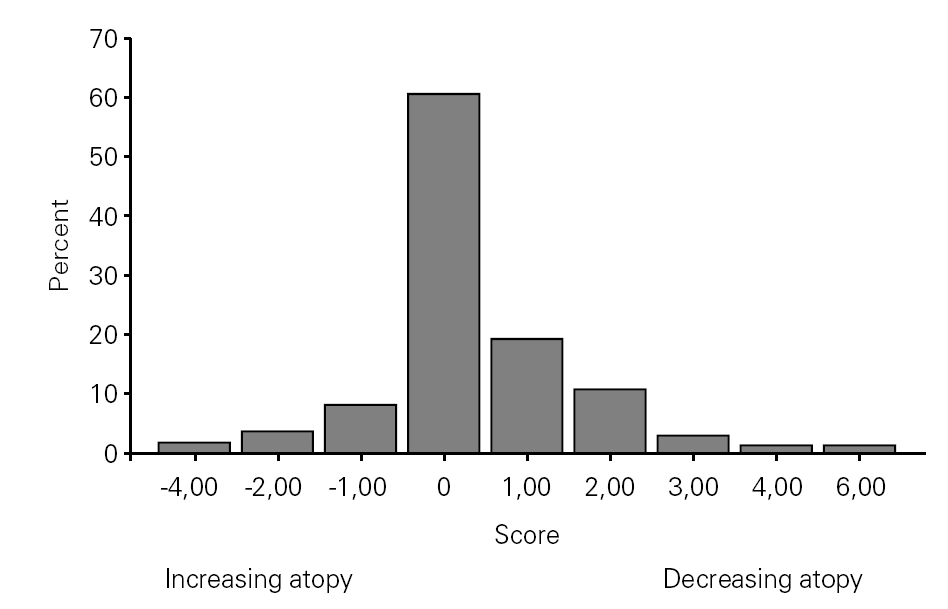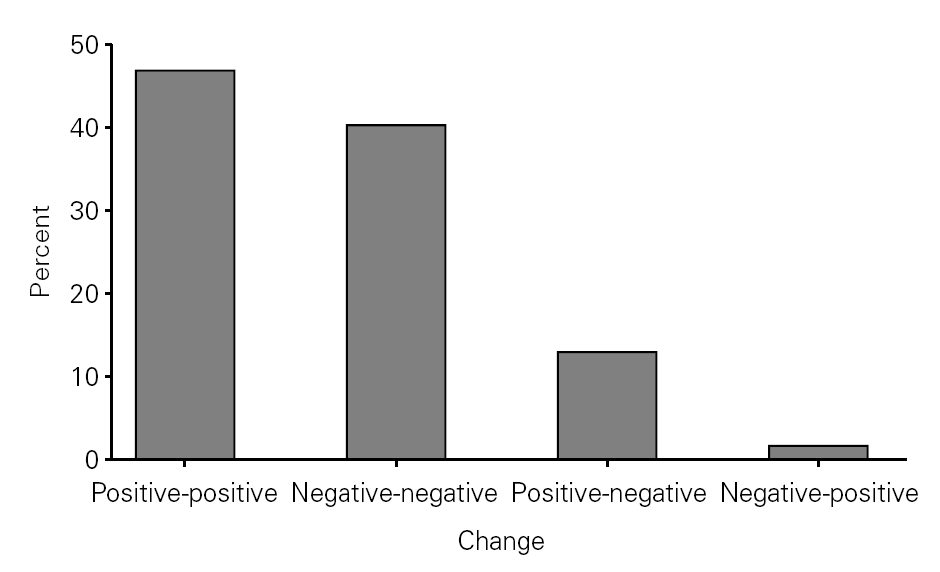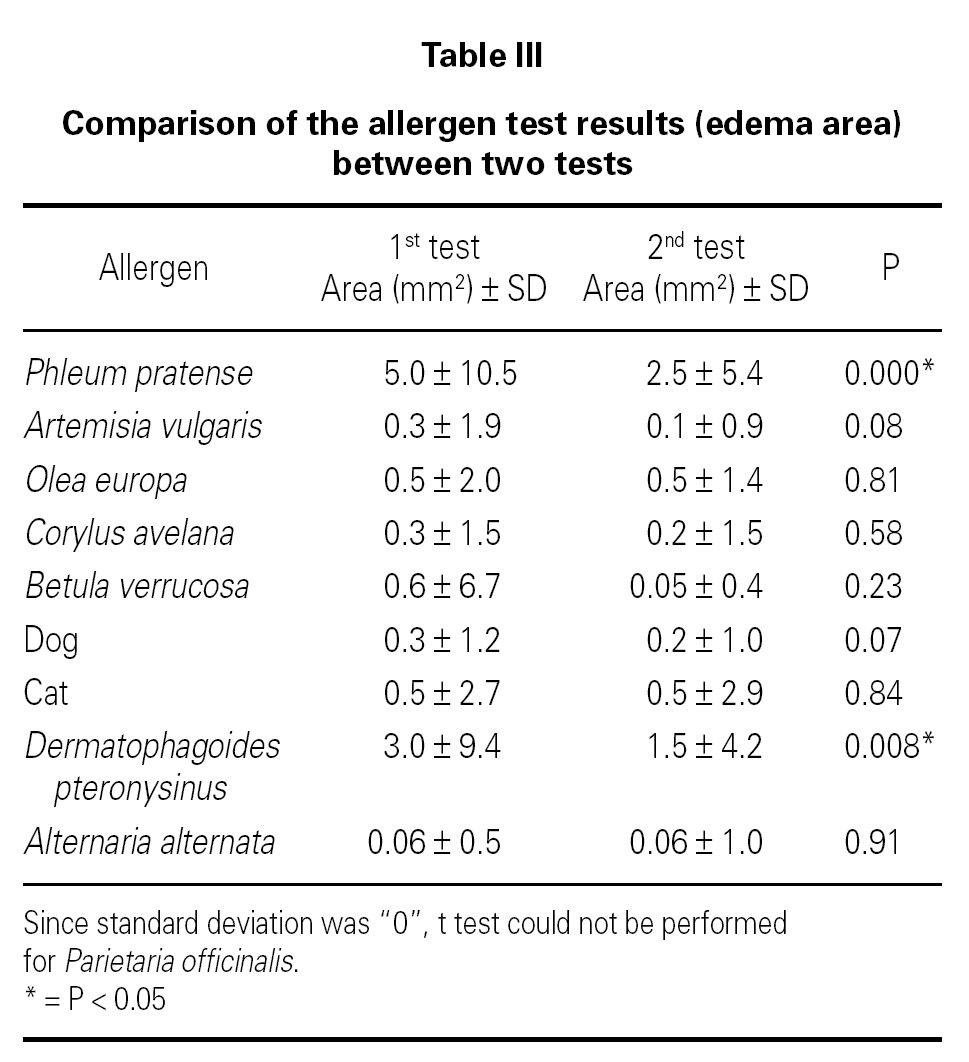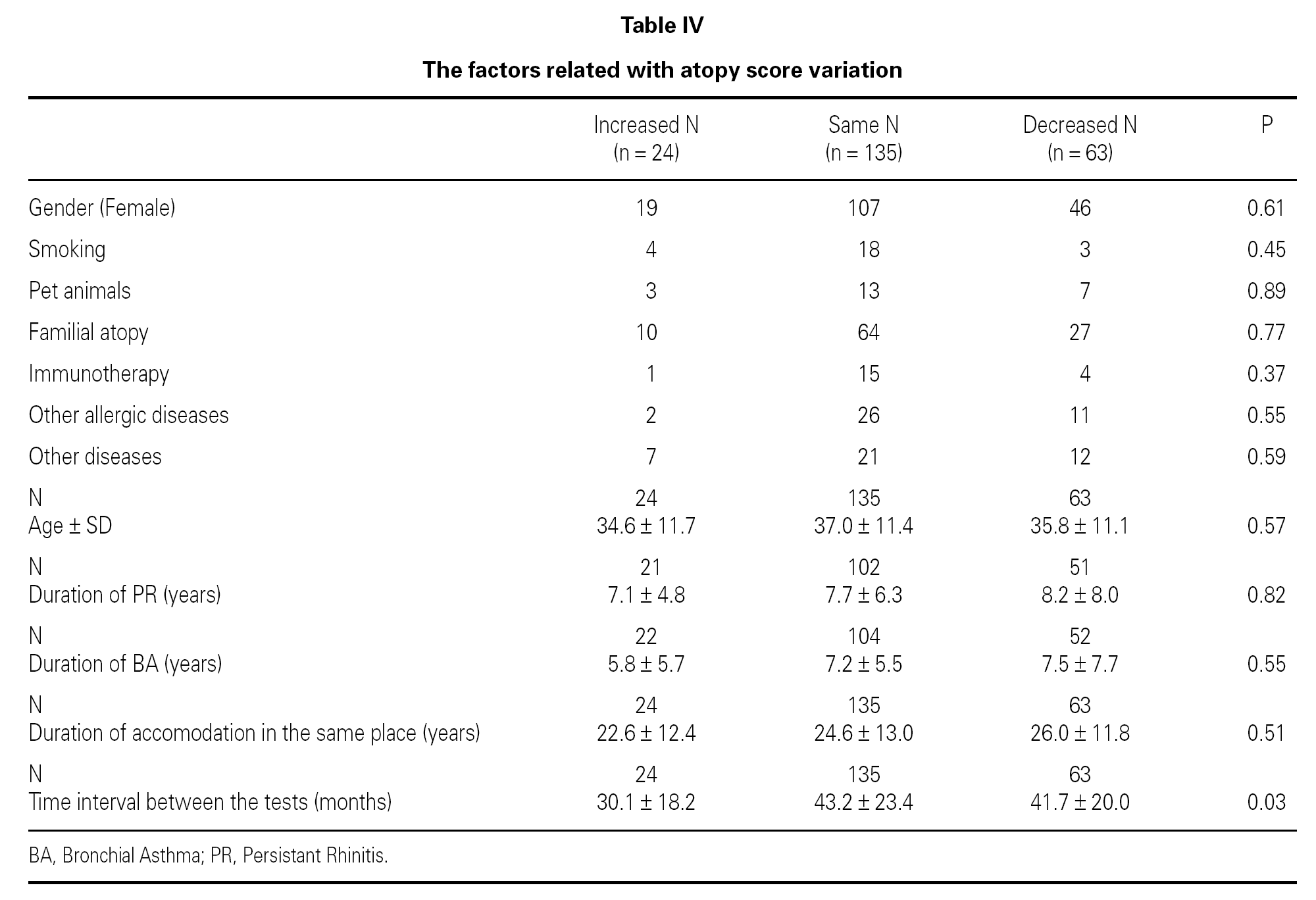INTRODUCTION
The sensitivity to allergens and histamine might change spontaneously in time or due to various treatment modalities like immunotherapy or some medications like antihistaminics or some other drugs. Repeated skin prick tests (SPTs) might be used to show new sensitizations or the natural desensitization. There are various longitudinal survey reports in the English medical literature performed to show the natural course of the SPTs 1-6. However, the subjects mainly consisted of children and adolescent age groups, except one survey in which the children and the adults have been evaluated together 2. In addition, the long-term changes in the SPT sensitivity and the levels of antibody have been observed in relation to changes in the disease severity 7. In none of these surveys has the adult patient group been studied alone, or the edema area for the allergens has been calculated and compared over time and in some of them only the normal population has been enrolled.
The aim of this survey was to repeat the allergic evaluation and determine possible changes appearing in time. SPT was the preferred method since it is a cheaper and easily performed test with higher specificity and sensitivity compared to the serologic test. Whether the patients had atopy and if there was any change in the amount of atopy and the allergen spectrum of the atopic patients, and if there were various factors affecting this change were evaluated.
MATERIAL AND METHODS
Two hundred twenty two adult patients who have been admitted to our Adult Allergy Unit for a period of two years prospectively and consecutively for routine control visits, and who had been diagnosed with persistant rhinitis and/or bronchial asthma at least two years ago in the same clinic have been enrolled in the survey. Informed consent was obtained from all patients. Data was collected on age, gender, diagnosis, duration of the disease, the history of receiving immunotherapy, other accompanying allergic and/or other systemic diseases and familial atopy by a standard questionnaire filled in by a fellow training in allergy face to face. The results of the SPTs which were performed at least two years ago from the files and the ones in the control visit were recorded.
Ten standard antigen solutions of common aeroallergens (dermatophagoides pteronyssinus, phleum pratense, olea europaea, artemisia vulgaris, parietaria officinalis, corylus avellana, betula verrucosa, cat, dog and alternaria alternata) obtained from ALK (Denmark) and Greer (USA) were used in the tests. Short-acting antihistamines were quitted at least two days, hydroxizyne, ketotiphen and tricyclic antidepressants two weeks, long-acting antihistamines 2 weeks and astemizole 3 weeks before the tests. The standard antigen solutions were applied before pricking the skin of the volar aspect of the forearm with a special lancet having 1 mm tip 8. Histamine and saline were used as positive and negative controls, respectively. All of the tests were performed by the same three experienced health technicians. The largest diameter of the edema and the second diameter 90 degrees to this were recorded separately and the mean of these two diameters was considered during the evaluation of the test results. The mean diameter larger than three mm was considered as "positive result". Edema area was calculated by the mean diameter calculated by the largest diameter (d1) and the one 90 degrees to this one (d2):
A = πr 2
A (mm 2) = Edema area
r = (d1 + d2) / 4
"Atopy" with SPT was defined as a positive reaction to any one of the allergens. Familial atopy was defined as having asthma, allergic rhinitis and atopic dermatitis in first degree relatives.
STATISTICAL ANALYSIS
SPSS for Windows 11.5 statistical programme was used for data analysis. The means and standard deviations of numerical values were calculated.
Paired t test was used for the comparison of the measurements performed in different times (edema area for the positive ones in at least one test). Chi-square and Fisher's exact test when required were used for the comparisons of the rates of the two groups.
Kappa statistics was used to evaluate the differences in the SPT results performed in different times. Kappa value greater than 70 % was accepted as "very good", 60-70 % "good, 50-60 % "moderate", and 40-50 % and smaller than this as "bad". P < 0.05 was accepted as statistically significant in all tests. In addition, atopy score was calculated for each patient (atopy score = positive allergen number in the first test positive allergen number in the second test).
RESULTS
The mean age of the patients was 36.4 ± 11.4 (minimum = 17; maximum = 68) and 172 (77.5 %) were females. Twenty five (11.3 %) had smoked or currently have been smoking; 23 (10.4 %) had pet animals; 20 (9 %) had received immunotherapy before the first test; and 10 (4.5 %) had changed their place of accomodation between the two tests. None of the patients has received immunotherapy in between the two tests. One hundred seventy seven (79.7 %) patients had bronchial asthma, 183 (80 %) persistant rhinitis, and 129 (56.9 %) had persistant rhinitis and bronchial asthma. Familial atopy rate was 45.5 % (n = 101), rate of other accompanying allergic diseases was 17.6 % (n = 39) and the rate of other accompanying diseases other than allergy was 18 % (n = 40).
There was a mean time interval of 43.4 ± 20.0 months (minimum = 24; maximum = 105) between the two tests. The comparison of the allergen spectra in the two tests is shown in table I. There was a statistically significant decrease in the positivity rate of the 10 allergens used in the two tests performed at least in two year interval. Except for olea europaea, allergen positivity rates were decreased in the second test. The atopy rate was 58.6 % (n = 130) in the first test which decreased to 47.7 % (n = 106) in the second test (p < 0.05) (table I).
The evaluation of the differences between the two tests for each allergen is given in table II. Stabilitiy for SPT in general was 73.2 %, and it was 84.7 % for phleum pratense, 33.5 % for artemisia vulgaris, 35.7 % for olea europaea, 52.3 % for corylus avelana, 29 % for betula verrucosa, 57.2 % for cat, 53.3 % for dermatophagoides pteronyssinus and 49.7 % for alternaria alternata. There was a moderate level of (50 %) stability (staying the same). Changes in the total atopy scores are shown in figure I. The stability and change rates are given in figure II.
Figure 1.--"0" shows no change, negative numbers increase and positive numbers decrease in atopy score in the second test.
Figure 2.--Stability and change rates in atopy state determined by SPT.
The comparison of the positive response edema areas for each allergen in the two tests showed that the edema areas for phleum pratense and dermatophagoides pteronyssinus were statistically significantly decreased in the second tests (p < 0.05) (table III). The edema areas for histamine were 6.0 ± 2.8 and 5.9 ± 2.8 mm 2 for the first and the second tests, respectively, which showed no statistically significant difference (p > 0.05). The relation between the atopy score variation and various factors is shown in table IV. There was an increase in the atopy score in the tests repeated after a mean period of 30 months, and stability or decrease in the ones repeated after a relatively longer period of 40 months or more (p < 0.05; table IV).
The only factor which affected the atopy score variation was the "time interval between the two tests" (p < 0.05).
DISCUSSION
The natural course of the results of the various tests in time used for the diagnosis of allergy seems to be interesting. SPT is a cheap and safe method for the researchers who want to perform surveys in this area. There are many surveys performed by using this method 1-7. Except one, all of these surveys are performed in the pediatric and adolescent age groups 7 and except three, all the others in healthy individuals 1,4,7. However, when these surveys are examined in detail it appears that there are not only differences in the groups but also methodology of the test protocols, the number of allergens used and the positivity criteria of the tests. So it is hard to compare these surveys with each other and with ours. There was a statistically significant increase in the atopy rate in general and sensitivity to each allergen, in both specific IgE levels and SPT performed in children and adolescents. The only study in adults was performed with the aim of showing the change in the specific IgE level for dermatophagoides pteronyssinus and phleum pratense in time, in which the SPT are not given in detail, mentioned that there was no statistically significant change 7. Similar surveys in adults were all performed to evaluate the results of immunotherapy. Due to these reasons, to the best of our knowledge our study is the first large study in the literature on this subject.
The number of patients and the collected data is sufficient when the reliability of the results and the statistical evaluation is considered. The largest group consists of asthmatics, which is followed by patients with persistent rhinitis. Since the age spectrum is between 17 and 68 years, it is not odd that 39 (17.6 %) had other allergic and 40 (18 %) non-allergic chronic diseases.
The repetition of the SPT are performed in the same laboratory, by the same technician team, by the same method and by the same allergens bought from the same companies. So there seems to be no technical problem which could effect the results. The atopy rate decreased from 58.6 % to 47.7 % and this decrease was significant, when the evaluation for atopy by SPT was repeated after a mean period of 43.4 months. Although showing the decrease in atopy determined by SPTs at the same time in different age groups is a well known phenomenon, it is an original result to show the same phenomenon in the same adult patient group prospectively. However, SPT results changed from positive to negative in 27 (12.2 %) patients, in contrast they changed from negative to positive in only three (1.4 %) patients, when the test results are examined in more detail. Although there was statistically significant decrease in the sensitivity rates to all of the allergens by time, there was a significant increase in olea europaea. This increase might be due to the heap up of the olea europaea sensitive patients in the group of patients who had changed their place of accommodation in between two tests. The atopy score increased in only 24 (10.8 %) patients where it stayed stabile or decreased in the remaining almost 90 %.
Gender, smoking, having pets, immunotherapy received previously, familial atopy, age and the duration of accommodation in the same place did not have significant contribution on the atopy score determined by SPT when the effect of various factors during the study period are investigated. No significant effect of immunotherapy might be both due to small number of patients receiving immunotherapy (n = 20) and having this treatment modality before the first test. The only factor that is determined to be effective in atopy score change is the "increasing time in between the tests". The point which should be paid careful attention is the increase in the atopy score in the tests repeated after a mean period of 30 months, and stability or decrease in the ones repeated after a relatively longer period of 40 months or more.
There is a dominant opinion in the allergy literature that the most important and effective method decreasing the allergen sensitivity in atopic individuals and patients is immunotherapy. However, "time" also affects the SPT results. Although the atopy rate increases in children and adolescents, there is no detailed data about the natural course in adults 1,2,4. In addition to medical treatment, our patients have been educated for the methods of allergen and irritant avoidance measures, which might also have a role in staying stabile or decrease of atopy score in almost 90 % of the patients. There are many surveys in the literature supporting this result 9-13.
There are also some surveys performed about factors like various bacterial, viral and parasitic infections which might be effective on atopy and its change 14-21. Negative relation is reported between tuberculin skin test positivity and atopic diseases in a survey performed in Japan 14. The authors stated that exposure and response to mycobacterium tuberculosis could be effective in changing the immune profiles. In addition, it was hypothetically reported that the decrease in tuberculosis infection lied under the increase in the severity and prevalence of atopic diseases in developed countries 18. It was determined that the atopy rate determined by SPT was statistically significantly lower in the patients whose HAV antibodies were positive 15. Our country is among the countries with high infectious diseases rate, and the real prevalence of the many infectious diseases is not clear. So, it might be thought that a previous infectious disease or a one in between the two tests might affect the result of the second test. However this has not been investigated in our survey.
In conclusion, SPT repetition shows a higher rate of change in the patients who are atopic in the first test. Atopy determined by SPT tends to decrease with time in general and the most important factor affecting this decrease seems to be the "time itself".
Correspondence:
G. Karakaya, M.D.
Hacettepe University
School of Medicine
Dept. of Chest Diseases
Adult Allergy Unit
O6100 Shhiye Ankara Turkey
Phone: + 90 312 3051531
Fax: + 0 312 3100809
E-Mail: gkarakay@hacettepe.edu.tr



